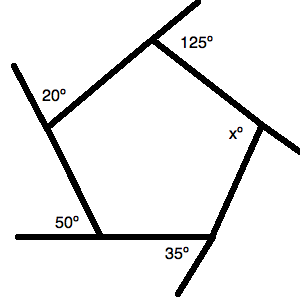All ACT Math Resources
Example Questions
Example Question #21 : Geometry
Suppose the side length of a pentagon is 
Write the formula for the area of a pentagon.
Substitute the side length and simplify the radical.
Example Question #21 : Plane Geometry
One side of a regular pentagon is 
In a regular pentagon, all of the sides are the same length.
The perimeter can then be found by summing all 


Example Question #1 : How To Find The Perimeter Of A Pentagon

What is the perimeter of the regular pentagon pictured above?
The answer cannot be determined.
The key word in this question is "regular." Since the pentagon is regular, all of its sides are equal. This means that it, in fact, looks like:

The perimeter for this is simply 

Example Question #31 : Geometry
A regular pentagon has a side length of 
Because we're told the pentagon is a regular polygon, this means that all of its sides are the same length. That is, the side lengths are congruent.
In order to solve for the perimeter, which is the sum of all sides, we can use a multiplication shortcut of:




Using the information given in the problem, the values can be substituted in.
Note that this math is the same as adding 
Example Question #11 : Pentagons

The figure above is a pentagon. All of the angles listed (except the interior one) are exterior angles to the pentagon's interior angles.
What is the value of 
There are two key things for a question like this. The first is to know that a polygon has a total degree measure of:


Therefore, a hexagon like this one has:

Next, you should remember that all of the exterior angles listed are supplementary to their correlative interior angles. This lets you draw the following figure:

Now, you just have to manage your algebra well. You must sum up all of the interior angles and set them equal to 
Solve for 
Example Question #33 : Geometry

The figure above is a pentagon. All of the angles listed (except the interior one) are exterior angles to the pentagon's interior angles.
What is the value of the largest unknown angle in the figure above?
There are two key things for a question like this. The first is to know that a polygon has a total degree measure of:


Therefore, a hexagon like this one has:

Next, you should remember that all of the exterior angles listed are supplementary to their correlative interior angles. This lets you draw the following figure:

Now, you just have to manage your algebra well. You must sum up all of the interior angles and set them equal to 
Solve for 
Now, you have to find the largest unknown angle, which is 
Example Question #34 : Geometry
What is the sum of three angles in a pentagon?
The sum of all angles is determined by the following formula for a polygon:
In a pentagon, there are 5 sides, or 
There are 5 interior angles in a pentagon. Divide the total possible angle by 5 to determine the value of one interior angle.
Each interior angle of a pentagon is 108 degrees.
The sum of three angles in a pentagon is:
All ACT Math Resources


























































